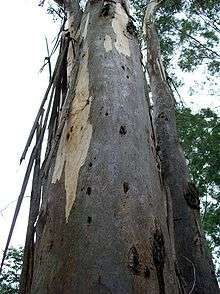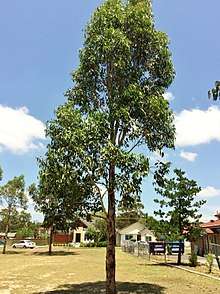Eucalyptus amplifolia
| Cabbage gum | |
|---|---|
 | |
| Cabbage gum, bark | |
| Scientific classification | |
| Kingdom: | Plantae |
| Clade: | Angiosperms |
| Clade: | Eudicots |
| Clade: | Rosids |
| Order: | Myrtales |
| Family: | Myrtaceae |
| Genus: | Eucalyptus |
| Species: | E. amplifolia |
| Binomial name | |
| Eucalyptus amplifolia | |
Eucalyptus amplifolia, known as the cabbage gum, is a common eucalyptus tree of the coastal areas and tablelands of New South Wales and adjacent areas in south eastern Queensland, occurring as far south as Bega.
Description

The cabbage gum can grow to 30 metres in height in forest situations, though it is often shorter in sparser woodland areas. It is often found by streams in lower moister sites, in grassy woodlands, and in the deeper loamy type soils. It has smooth, often blotchy, white, cream, yellow, grey, pink or blue-grey bark throughout the trunk and branches, usually with loose, flaking grey slabs persistent at the base and lower trunk.[1]
Juvenile leaves are rounded, egg-shaped or triangular in shape, green, 5 to 22 cm long by 3.5 to 18 cm wide, and predominately held horizontal to the ground. Adult leaves are alternate on the stem with a petiole 1 to 3 cm long, are broadly lanceolate in shape, 7.5 to 25 cm long by 1.5 to 7 cm wide, . Side-veins are 45° or greater to the midrib, and the leaves are of a dull or glossy green of same hue both sides of the leaf.[1]
The gumnuts (fruit) are small, hemispherical in shape 0.2 to 0.5 cm long by 0.4 to 0.6 cm in diameter, with pedicel (stalk) 0.1 to 0.5 cm long, raised disc (top surface) and 3 or 4 exserted valves (sharp wooden points emerging out of the top of the gumnut).[1]
The name Eucalyptus amplifolia derives from the Latin amplus: large, + folia: leaves, referring to the foliage.[1]
Sub species

A variant of the cabbage gum grows in northern New South Wales, occurring in the Tenterfield, Armidale and Casino districts and adjacent areas in Queensland. This sub-species sessiliflora has no, or almost no, pedicel (stalk) on its flowers and gumnuts, while the more common subsp. amplifolia has gumnut and flower pedicels of up to 0.5 cm in length.[1]
Gallery
- Features of the cabbage gum (Eucalyptus amplifolia)
 Leaves
Leaves Bark and leaves
Bark and leaves Buds
Buds Fruit
Fruit Trunk bark
Trunk bark
References
- "Eucalyptus amplifolia". PlantNET - NSW Flora Online. Retrieved 2010-03-18.
- A Field Guide to Eucalypts - Brooker & Kleinig volume 1, ISBN 0-909605-62-9 page 162